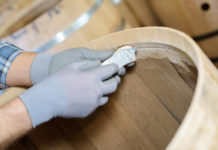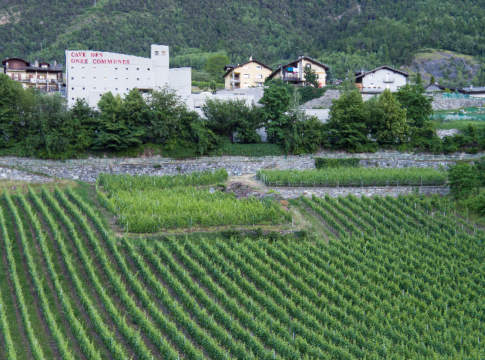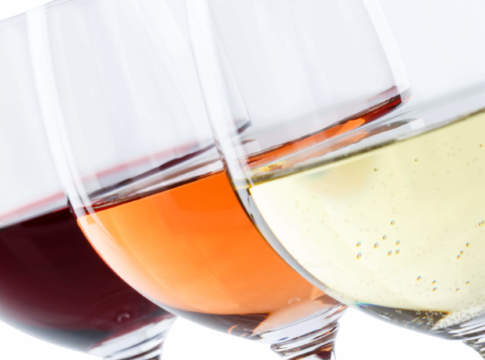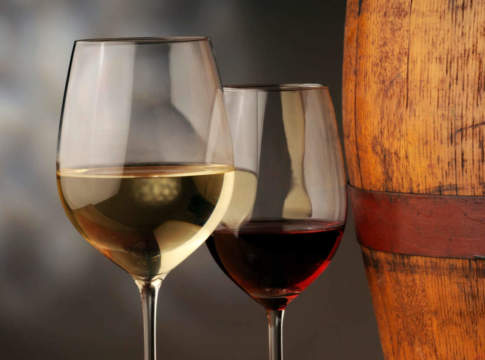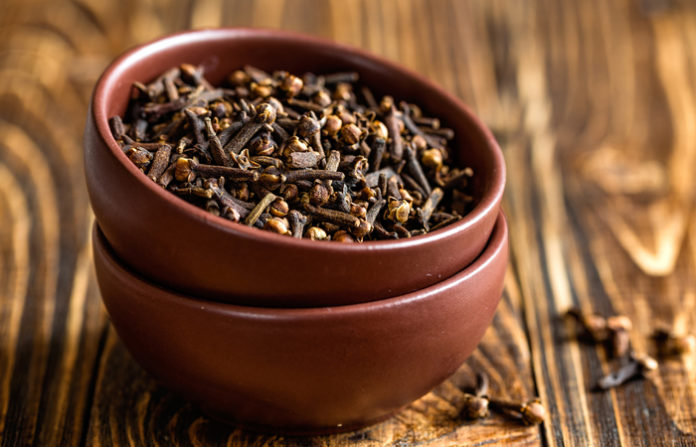
La maturazione dei vini in botti di rovere determina nel prodotto un complesso mix di sfumature organolettiche che ricordano cocco, legno, vaniglia, spezie e tostato. Centinaia di composti volatili derivanti dal legno di quercia sono stati identificati nelle bevande alcoliche invecchiate in botti e barrique e certamente uno dei focus degli ultimi anni della ricerca in campo enologico è stato proprio rappresentato dall’identificazione e quantificazione delle molecole aromatiche estratte durante questo processo. Vanillina (sentore di vaniglia), β-metil-γ-ottalattone (cocco), fenoli volatili (spezie) e 2-furanmentantiolo (tostato) sono considerati le molecole chiave associate all’invecchiamento in barrique, tonneau e botti e al trattamento con legni alternativi. Molte altre sostanze olfattivamente attive – originariamente presenti in quercia o che si sviluppano durante la tostatura – sono legate direttamente o indirettamente all’invecchiamento in legno di quercia, con conseguente incremento della complessità dei prodotti sottoposti a questo processo. Il vanilliltiolo, identificato per la prima volta in vino e in natura, responsabile di note speziate di chiodo di garofano, è presente in vino in quantità fortemente legate alla durata e alle modalità di maturazione in legno.
Per approfondire
Bibliografia Allen, M. S., M. J. Lacey, et al. (1994). “Determination of methoxypyrazines in red wines by stable 446 isotope dilution gas chromatography mass spectrometry.” J. Agric. Food Chem. 42: 1734-1738. Ancín, C., T. Garde, et al. (2004). “Extraction of volatile compounds in model wine from different oak woods: Effect of SO2.” Food Research International 37(4): 375-383. Blanchard, L., P. Darriet, et al. (2004). “Reactivity of 3-mercaptohexanol in red wine: Impact of oxygen, phenolic fractions, and sulfur dioxide.” Am. J. Enol. Vitic. 55(2): 115-120. Blanchard, L., T. Tominaga, et al. (2001). “Formation of furfurylthiol exhibiting a strong coffee aroma during oak barrel fermentation from furfural released by toasted staves.” Journal of Agricultural and Food Chemistry 49(10): 4833-4835. Blanchard, L., T. Tominaga, et al. (2001). “Formation of furfurylthiol exhibiting a strong coffee aroma during oak barrel fermentation from furfural released by toasted staves.” J. Agric. Food Chem 49(10): 4833-4835. Brown, R. C., M.A. Sefton, et al. (2006). “An odour detection threshold determination of all four possible stereoisomers of oak lactone in a white and red wine.” Aust. J. Grape Wine Res. 12: 115-118. Chatonnet, P., J. N. Boidron, et al. (1989). “Effect of heat on oak wood and its chemical composition. Part 2. Variations of certain compounds in relation to toasting intensity.” Connaiss. Vigne Vin 23: 223-250. Chatonnet, P., J. N. Boidron, et al. (1990). “Maturation of red wines in oak barrels: Evolution of some 465 volatile compounds and their aromatic impact.” Sci. Aliment. 10: 565-587. Chatonnet, P., D. Dubourdieu, et al. (1991). “Effects of fermentation and maturation in oak barrels on the composition and quality of white wines.” Aust. N. Z. Wine Ind. J. 6: 73-84. Chatonnet, P., D. Dubourdieu, et al. (1992). “Incidence des conditions de fermentation et d’élevage des vins blancs secs en barriques sur leur composition en substances cédées par le bois de chêne.” Sci. Ali. 12: 665-685. Coetzee, C. and W. J. du Toit (2012). “A comprehensive review on Sauvignon blanc aroma with a focus on certain positive volatile thiols.” Food Research International 45(1): 287-298. Cutzach, I., P. Chatonnet, et al. (1997). “Identification of Volatile Compounds with a “Toasty” Aroma in Heated Oak Used in Barrelmaking.” Journal of Agricultural and Food Chemistry 45(6): 2217-2224. Darriet, P., T. Tominaga, et al. (1995). “Identification of a powerful aromatic component of Vitis vinifera L. var. Sauvignon wines: 4-mercapto-4-methylpentan-2-one.” Flavour Frag. J. 10(6): 478 385-392. de Simón, B. F., E. Cadahía, et al. (2010). “Volatile composition of toasted oak chips and staves and of 480 red wine aged with them.” American Journal of Enology and Viticulture 61(2): 157-165. Ferreira, V., I. Jarauta, et al. (2004). “Simple strategy for the optimization of solid-phase extraction procedures through the use of solid-liquid distribution coefficients application to the determination of aliphatic lactones in wine.” J. Chromatogr. A 1025(2): 147-156. Gauthier, J. Y., F. Bourdon, et al. (1986). “A mild and efficient synthesis of thiolesters from alcohols.” Tet. Lett. 27(1): 15-18. Han, C. C. and R. Balakumar (2006). “Mild and efficient methods for the conversion of benzylic bromides to benzylic thiols.” Tet. Lett. 47(47): 8255-8258. Kipnis, F., I. Levy, et al. (1949). “Mercaptans from Aldehydes.” Journal of the American Chemical Society 71(6): 2270-2270. Kipnis, F. and J. Ornfelt (1949). “2-Acetylfuran diethyl mercaptol.” JACS 71(6): 2271. Kofod, H. (1963). “2-Furfuryl Mercaptan.” Organic Syntheses, Coll. 4. Langen, J., C.-Y. Wang, et al. (2013). “Quantitative analysis of γ- and δ-lactones in wines using gas 493 chromatography with selective tandem mass spectrometric detection.” Rapid Commun. Mass Sp. 27(24): 2751-2759. Mayr, C. M., D. L. Capone, et al. (2015). “Quantitative Analysis by GC-MS/MS of 18 Aroma Compounds Related to Oxidative Off-Flavor in Wines.” J. Agric. Food Chem. 63(13): 3394-3401. Molina, P., M. Alajarin, et al. (1985). “One pot conversion of alkyl halides into thiols under mild conditions.” Tet. Lett. 26(4): 469-472. Nikolantonaki, M., I. Chichuc, et al. (2010). “Reactivity of volatile thiols with polyphenols in a wine-501 model medium: Impact of oxygen, iron, and sulfur dioxide.” Anal. Chim. Acta 660(1-2): 102-109. Nikolantonaki, M. and P. Darriet (2011). “Identification of ethyl 2-sulfanylacetate as an important off-odor compound in white wines.” J Agric Food Chem 59(18): 10191-10199. Pérez-Prieto, L. J., J. M. López-Roca, et al. (2003). “Extraction and formation dynamic of oak-related 506 volatile compounds from different volume barrels to wine and their behavior during bottle storage.” J. Agric. Food Chem. 51(18): 5444-5449. Roland, A., F. Cavelier, et al. (2012). “How organic and analytical chemistry contribute to knowledge of the biogenesis of varietal thiols in wine. A review.” Flavour and Fragrance Journal 27: 266-510 272. Roland, A., R. Schneider, et al. (2011). “Distribution of varietal thiol precursors in the skin and the pulp of Melon B. and Sauvignon Blanc grapes.” Food Chemistry 125(1): 139-144. Sarrazin, E., S. Shinkaruk, et al. (2007). “Odorous Impact of Volatile Thiols on the Aroma of Young Botrytized Sweet Wines: Identification and Quantification of New Sulfanyl Alcohols.” J. Agric. Food Chem 55(4): 1437-1444. Spillman, P. J., A. P. Pollnitz, et al. (1997). “Accumulation of vanillin during barrel-aging of white, red, and model wines.” J. Agric. Food Chem. 45: 2584-2589. Tominaga, T., L. Blanchard, et al. (2000). “A powerful aromatic volatile thiol, 2-furanmethanethiol, exhibiting roast coffee aroma in wines made from several Vitis vinifera grape varieties.” J Agric Food Chem 48(5): 1799-1802. Tominaga, T., L. Blanchard, et al. (2000). “A powerful aromatic volatile thiol, 2-furanmethanethiol, exhibiting roast coffee aroma in wines made from several Vitis vinifera grape varieties.” J. 523 Agric. Food Chem 48(5): 1799-1802. Tominaga, T., P. Darriet, et al. (1996). “Identification of 3-mercaptohexyl acetate in Sauvignon wine, a powerful aromatic compound exhibiting box-tree odor.” Vitis 35(4): 207-210. Tominaga, T., A. Furrer, et al. (1998). “Identification of new volatile thiols in the aroma of Vitis vinifera L. var. Sauvignon blanc wines.” Flavour Frag. J. 13(3): 159-162. Tominaga, T., G. Guimbertau, et al. (2003). “Contribution of benzenemethanethiol to smoky aroma of certain Vitis vinifera L. wines.” J. Agric. Food Chem. 51(5): 1373-1376. Tominaga, T., M. L. Murat, et al. (1998). “Development of a method for analyzing the volatile thiols involved in the characteristic aroma of wines made from Vitis vinifera L. cv. Sauvignon blanc.” J. Agric. Food Chem. 46: 1044-1048. Tominaga, T. D., D. (2004). Acquisition récentes sur le caractère torréfié des vins élaborés en fûts de chêne. Actes du colloque pour conférence de Seguin Moreau à l’occasion de Vinitech, Bordeaux, Seguin-Moreau. Ugliano, M., M. Kwiatkowski, et al. (2011). “Evolution of 3-mercaptohexanol, hydrogen sulfide, and methyl mercaptan during bottle storage of Sauvignon blanc wines. Effect of glutathione, copper, oxygen exposure, and closure-derived oxygen.” J. Agric. Food Chem 59(6): 2564-539 2572. van Gemert, L. J. (2003). Flavour thresholds, Oliemans Punter & Partners BV. Zarzo, M. (2007). “The sense of smell: Molecular basis of odorant recognition.” Biological Reviews 542 82(3): 455-479. Zheng, T. C., M. Burkart, et al. (1999). “A general and mild synthesis of thioesters and thiols from halides.” Tet. Lett. 40(4): 603-606.


